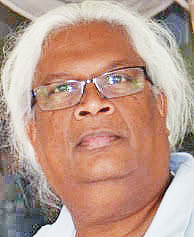Opinions
The "Coolie" Slur

As we enter a period of reflection on South Asian Heritage, we devise ways to enhance our people, reveal their true history, and settle impeding or divisive issues. If you thought “Paki” was offensive, try “coolie”. I am not a “coolie”, never was; neither are you! Original migrants copied its usage from the British – as all colonial language was, without questioning origin or meaning; employers had used it pejoratively in addressing workers, initially to Chinese, later Indians.
The first shipment of Chinese labourers came to Trinidad in 1806; the first Indians to British Guiana (now Guyana) on May 5th, 1838. The workers were not language students, just learning to communicate in a strange and complex tongue, with a different syntax, and copying their employers’ way of speaking, without any guidance on word choice, meaning, or grammar, thrown into the deep end, as it were; to their credit, they learned to communicate in their employers’ slang.
But with the inevitable acquisition of knowledge, the insult was recognised, and the usage criticised and condemned, starting at least a century ago, in British Guiana, when Mr AS Khan wrote in a letter to the Argosy newspaper on 13 June 1906: “coolies are labourers such as … do odd jobs, and you will find EI’s in positions other than those.”
Some years later, in a prompt correction of a local black teacher’s generic use of “coolie” in a gathering of independent farmers, my nana, who had been one of many entrepreneurs in pioneering agriculture away from sugar plantations, cautioned, “It’s an insulting word, teacher, like nigger; bakra used to call Chinee ‘coolies’, but stopped; don’t call me coolie, and I won’t call you nigger!” The teacher thanked him and never repeated that usage.
Mr Das, the Deputy Principal of Berbice High School in the mid-nineteen forties, caned a black boy for wilful teasing of an Indian girl as “coolie gal!” He cautioned the school at the following morning’s general assembly, identified other hurtful words and ethnic slurs, stressing racial insults, which the school would like to see eliminated. He mentioned the work of Jamaican Marcus Garvey in the USA, his ‘back to Africa” movement and its language cautions. Thus, Black people would more easily understand, as they have struggled long and steadily to blacklist the word “nigger”, corrupted from its legitimate Iberian parent “negro”.
Finally the word dropped out of use, until Black to Black usage revived it as “nigga” in rap poetry.
Similarly, the usage of the “c” word had declined in Guyana and Triniidad until the racial “wars” of the late 1950s and thereafter, as Jagan and Burnham in Guyana and Eric Williams in Trinidad polarised the populations. American influence, the spread of “black power” and visits of its advocates revived ethnic issues.
In recent years the “c” word has sadly resurfaced, mainly by diasporal Indians, both PIOs and NRIs, who are too misinformed by an incomplete education, or not sensitive enough to realise the burden of the term: the self-denigration of equating “coolie” with “Indian”, which devalues the person, perpetuates the contempt, and belittles the dignity of labour.
It seems fashionable among young female Indian writers of Guyanese and Trinidadian background, particularly those nurtured and educated in North America or Britain, ignorant of their history or that of indentureship, and practising as journalists or new intellectuals; they write authoritatively, but with poor cultural or historical depth, but try to fill the void in their upbringing. It’s as if some diasporal Indian writers regard it as the new chic, to the delight of western publishers (largely white, Christian, anti-Hindu, if not anti-Indian, who like to malign Indians); an example is a Ms Bahadur, with an unusual first name, Gaiutra – who has spun a tale with the insulting title, “Coolie Woman”, about her great grandmother, indentured to BG, as if she would welcome the revived insult that she must have heard a hundred times!
I wrote her my regrets over the title (however appealing it was to her American audience and publisher), and after reading her book suggested she read “The Indelible Red Stain” on Guyana, and “India, under siege…” for facts and opinions. Similarly, Ms Mahadai Das, a young poet in the 1970s overused it in slavish following of Forbes Burnham, until the fog cleared and she confirmed what people like me had warned her of: her idol’s anti-Indian biases.
In 2000, the South African parliament enacted a law to prevent use of hate terms such as “coolie”.
But with the inevitable acquisition of knowledge, the insult was recognised, and the usage criticised and condemned, starting at least a century ago, in British Guiana, when Mr AS Khan wrote in a letter to the Argosy newspaper on 13 June 1906: “coolies are labourers such as … do odd jobs, and you will find EI’s in positions other than those.”
Some years later, in a prompt correction of a local black teacher’s generic use of “coolie” in a gathering of independent farmers, my nana, who had been one of many entrepreneurs in pioneering agriculture away from sugar plantations, cautioned, “It’s an insulting word, teacher, like nigger; bakra used to call Chinee ‘coolies’, but stopped; don’t call me coolie, and I won’t call you nigger!” The teacher thanked him and never repeated that usage.
Mr Das, the Deputy Principal of Berbice High School in the mid-nineteen forties, caned a black boy for wilful teasing of an Indian girl as “coolie gal!” He cautioned the school at the following morning’s general assembly, identified other hurtful words and ethnic slurs, stressing racial insults, which the school would like to see eliminated. He mentioned the work of Jamaican Marcus Garvey in the USA, his ‘back to Africa” movement and its language cautions. Thus, Black people would more easily understand, as they have struggled long and steadily to blacklist the word “nigger”, corrupted from its legitimate Iberian parent “negro”.
Finally the word dropped out of use, until Black to Black usage revived it as “nigga” in rap poetry.
Similarly, the usage of the “c” word had declined in Guyana and Triniidad until the racial “wars” of the late 1950s and thereafter, as Jagan and Burnham in Guyana and Eric Williams in Trinidad polarised the populations. American influence, the spread of “black power” and visits of its advocates revived ethnic issues.
In recent years the “c” word has sadly resurfaced, mainly by diasporal Indians, both PIOs and NRIs, who are too misinformed by an incomplete education, or not sensitive enough to realise the burden of the term: the self-denigration of equating “coolie” with “Indian”, which devalues the person, perpetuates the contempt, and belittles the dignity of labour.
It seems fashionable among young female Indian writers of Guyanese and Trinidadian background, particularly those nurtured and educated in North America or Britain, ignorant of their history or that of indentureship, and practising as journalists or new intellectuals; they write authoritatively, but with poor cultural or historical depth, but try to fill the void in their upbringing. It’s as if some diasporal Indian writers regard it as the new chic, to the delight of western publishers (largely white, Christian, anti-Hindu, if not anti-Indian, who like to malign Indians); an example is a Ms Bahadur, with an unusual first name, Gaiutra – who has spun a tale with the insulting title, “Coolie Woman”, about her great grandmother, indentured to BG, as if she would welcome the revived insult that she must have heard a hundred times!
I wrote her my regrets over the title (however appealing it was to her American audience and publisher), and after reading her book suggested she read “The Indelible Red Stain” on Guyana, and “India, under siege…” for facts and opinions. Similarly, Ms Mahadai Das, a young poet in the 1970s overused it in slavish following of Forbes Burnham, until the fog cleared and she confirmed what people like me had warned her of: her idol’s anti-Indian biases.
In 2000, the South African parliament enacted a law to prevent use of hate terms such as “coolie”.
Close encounter of the
angry turkey kind
 Romeo Kaseram
Romeo Kaseram
It was an amazing discovery made two streets away. Here was a house standing on taller stilts, with a ladder similar to a chicken ramp leading up to its wooden front door. It struck me right away the house was unusual for its façade and height. Also, that its downstairs was tall enough for a grown man to walk under, with a blocked off area in a far corner serving as a smoky kitchen, for a hammock to swing between two of the thick tree trunks that were posts, and what caught my eyes right away, a work table on which sat a number of projects that were works-in-progress.
But first, my inventive mind found the front ladder to be a remarkable construction, similar to the ones on which my grandmother’s more unwieldy hens climbed up on evenings to roost, hobbling on swollen ankles, complaining and pecking at each other like tired, irascible old ladies. I made the remark to my new-found school friend, wondering what species of large fowl were living in his house, and whether the eggs laid were as large and round as watermelons.
I should have known better and kept my wise-cracking mouth shut. A few evenings later, for the benefit of my long-term memory, during an unscheduled visit to my new-found friend with the chicken-ladder at the front of his house, I encountered, and was chased by one of the worst antagonists I had ever met with my innocent-looking baby-face, my milk teeth yet to be pulled out with a string attached to a door handle, that constituted my young and inexperienced life.
Now to digress for a paragraph or two, or three, encounters with antagonists of the territorial, canine type were already a frequent occurrence early in my life. Such was my vast world of experience that as a young boy, I was already a veteran, with a few stitches to my leg, from two or three visits to the public hospital in the small town a few kilometers away from our sea of sugar cane fields.
It was to this hospital where I was taken by an irate and bothered grandmother for shots following a dog or two sinking sharp teeth into my juicy leg, its pace a blur of running haste, the failed attempt of an errant young boy, yours truly, to outrun a pack of strays constantly harassed with tossed rocks.
I cannot speak to our present generation of young men, but during my day growing up back home, to be chased by bad-dogs, and to unhappily receive its salivary ferocity from a bite or two to the calves were nothing less than rites-of-passage. Particularly for a naughty lad like myself, who specialised in surreptitiously lifting from flourishing trees numerous young green mangoes, ripening plums, sapodillas, and even braving slashes from the serrated crowns of purloined pineapples.
To be chased by a pack of dogs was a whole different kettle of fish, so to speak. However, in this instance, I called uninvited by my new friend in the large house with its chicken-coop façade, only to be greeted with an interrupted, questioning cackle. This cackle was an unusual sound in my youthful encyclopaedic history of known animal cries, and for a disorienting moment, I found myself wondering if I had indeed been correct all along – that the residents living in this house with the oblique ramp at its front door were indeed a larger, perhaps meatier, and sinister species of bird.
I was not far from being incorrect. It came out of the horizon, the turkey tom fired from its missile tubes with the coordinates set for my malnourished legs, recently scabbed from a close encounter with the prickly Sandbox tree in search of scattered seeds, and red with welts from well-nourished mosquitoes.
Its mass of black, white, and grey feathers were inflated with the hot air of its annoyance over my trespass, large wings lowered so huge feathers swept along the gravelled path, and the thick skin on the beak, its snood, engorged and burning as a red hot flame of escalating rage. As the tom charged, its head lowered and its toes spread wide, I heard its horny claws scraping and tossing the gravel behind, while screeching a war-cry similar to a witch’s mad, murderous cackle.
In that moment, birds stopped singing; fruit on trees halted ripening to shake with fear, and in the distance, a Sandbox fruit exploded, scattering seeds in the air as if a starting gun had been fired. I took off, running as if catapulted from starting blocks, drawing mightily from my experience being chased by dogs, with my head held down, arms levering at my sides, legs pumping from a direct feed into my adrenalin reservoir.
Some days I am regretful at how unjust aging can be, that as a young man I could have seriously challenged Usain Bolt in the 100-metre dash.
I burned asphalt fleeing down the street to my friend’s muffled laughter behind the fence, vowing to not make fun of his family, and to get even one day.
I should have known better and kept my wise-cracking mouth shut. A few evenings later, for the benefit of my long-term memory, during an unscheduled visit to my new-found friend with the chicken-ladder at the front of his house, I encountered, and was chased by one of the worst antagonists I had ever met with my innocent-looking baby-face, my milk teeth yet to be pulled out with a string attached to a door handle, that constituted my young and inexperienced life.
Now to digress for a paragraph or two, or three, encounters with antagonists of the territorial, canine type were already a frequent occurrence early in my life. Such was my vast world of experience that as a young boy, I was already a veteran, with a few stitches to my leg, from two or three visits to the public hospital in the small town a few kilometers away from our sea of sugar cane fields.
It was to this hospital where I was taken by an irate and bothered grandmother for shots following a dog or two sinking sharp teeth into my juicy leg, its pace a blur of running haste, the failed attempt of an errant young boy, yours truly, to outrun a pack of strays constantly harassed with tossed rocks.
I cannot speak to our present generation of young men, but during my day growing up back home, to be chased by bad-dogs, and to unhappily receive its salivary ferocity from a bite or two to the calves were nothing less than rites-of-passage. Particularly for a naughty lad like myself, who specialised in surreptitiously lifting from flourishing trees numerous young green mangoes, ripening plums, sapodillas, and even braving slashes from the serrated crowns of purloined pineapples.
To be chased by a pack of dogs was a whole different kettle of fish, so to speak. However, in this instance, I called uninvited by my new friend in the large house with its chicken-coop façade, only to be greeted with an interrupted, questioning cackle. This cackle was an unusual sound in my youthful encyclopaedic history of known animal cries, and for a disorienting moment, I found myself wondering if I had indeed been correct all along – that the residents living in this house with the oblique ramp at its front door were indeed a larger, perhaps meatier, and sinister species of bird.
I was not far from being incorrect. It came out of the horizon, the turkey tom fired from its missile tubes with the coordinates set for my malnourished legs, recently scabbed from a close encounter with the prickly Sandbox tree in search of scattered seeds, and red with welts from well-nourished mosquitoes.
Its mass of black, white, and grey feathers were inflated with the hot air of its annoyance over my trespass, large wings lowered so huge feathers swept along the gravelled path, and the thick skin on the beak, its snood, engorged and burning as a red hot flame of escalating rage. As the tom charged, its head lowered and its toes spread wide, I heard its horny claws scraping and tossing the gravel behind, while screeching a war-cry similar to a witch’s mad, murderous cackle.
In that moment, birds stopped singing; fruit on trees halted ripening to shake with fear, and in the distance, a Sandbox fruit exploded, scattering seeds in the air as if a starting gun had been fired. I took off, running as if catapulted from starting blocks, drawing mightily from my experience being chased by dogs, with my head held down, arms levering at my sides, legs pumping from a direct feed into my adrenalin reservoir.
Some days I am regretful at how unjust aging can be, that as a young man I could have seriously challenged Usain Bolt in the 100-metre dash.
I burned asphalt fleeing down the street to my friend’s muffled laughter behind the fence, vowing to not make fun of his family, and to get even one day.
